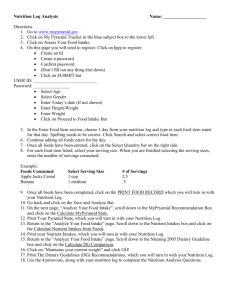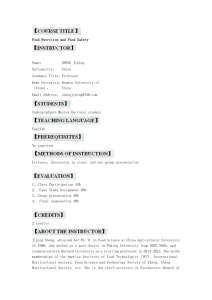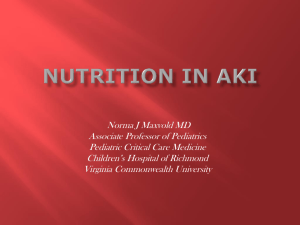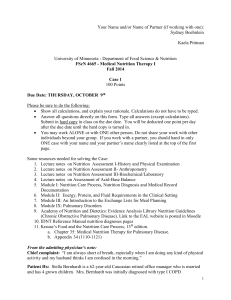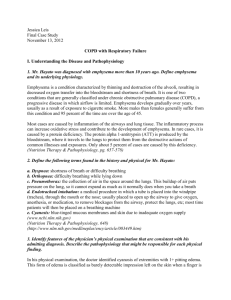File
advertisement
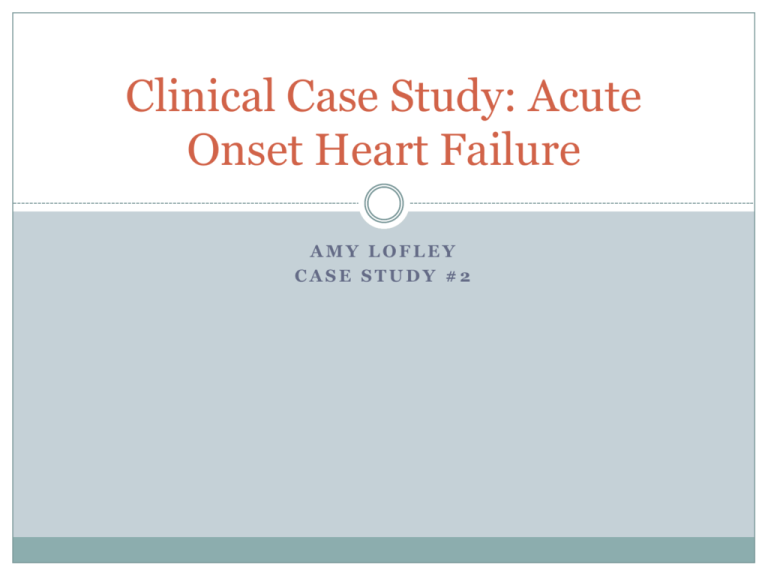
Clinical Case Study: Acute Onset Heart Failure AMY LOFLEY CASE STUDY #2 Objectives Overview of Acute Heart Failure Physiology Pathophysiology Treatment Multidisciplinary team Case Study Medical Hx Nutrition Assessment Nutrition Intervention Prognosis Conclusion Acute Heart Failure CLINICAL UPDATE Normal Physiology The heart pumps blood throughout the body to deliver oxygen and nutrients and bring back carbon dioxide and waste. A normal heart is able to pump this blood effectively throughout the body. http://filer.case.edu/dck3/heart/intro.html Pathophysiology (1) In heart failure the heart isn’t able to pump adequate blood supply to the rest of the body. This is indicated by a low ejection fraction and a high Bnatriuretic peptide (BNP). It does not mean that an individual has had a heart attack or that the heart is no longer working. The beginning stages of HF are usually asymptomatic and can progress if not treated. http://www.annerporterco.com/is-your-heart-failure-systolic-diastolic-or-both.html Pathophysiology http://www.annerporterco.com/is-your-heart-failure-systolic-diastolic-or-both.html Pathophysiology http://oyiabrown.com/2013/03/20/ Stages of Heart Failure (2) Classification of Heart Failure (1) Class I – No undue symptoms associated with ordinary activity and no limitation of physical activity Class II – Slight limitation of physical activity; patient comfortable at rest Class III – Marked limitation of physical activity; patient comfortable at rest Class IV – inability to carry out physical activity without discomfort; symptoms of cardiac insufficiency or chest pain at rest Risk Factors Hypertension DM Coronary Heart Disease Left ventricular hypertrophy Age Dyslipidemia \Obesity Atherosclerosis Practice Recommendations Primary treatment Treated with IV lasix Primary intervention MNT Fluid restriction 1500 mg Na restriction Evidence-Based Practice (3) Referral to a RD for MNT when an individual has HF. An initial visit lasting 45 minutes and up to three planned follow up visits lasting 30 minutes to improve diet and quality of life. Protein needs for patients are based on their nutrition status. Patients that are clinically stable but protein depleted should have at least 1.37 g/kg and patients with a normal nutrition status should have 1.12 g/kg actual body to preserve body composition and limit hypercatabolism. Evidence-Based Practice (3) Energy needs are best determined with indirect calorimetry but if not possible usual predictive equations should be used adjusting with increased needs for a catabolic state. Fluid should be limited to between 1.4 and 1.9 L per day, depending on symptoms of edema, fatigue, and shortness of breath. Sodium intake should be limited to less than 2000 mg per day from AND and 1500 mg from the AHA. Patients with HF should consume the DRI for folate, B6, and B12. A multi-vitamin/mineral should be recommended that contains B12, B6 and folate. Evidence-Based Practice (3) Thiamine status should be monitored closely because of diuretic use. Encouraging the patient to consume the DRI of thiamine is important until further research is conducted. Magnesium should be consumed at the DRI because of the increased risk for HF patients to have an irregular heart beat. Multidisciplinary team Physician Hospitalist Cardiologist Registered Dietitian Nurses PCT RN HF RN Case Study Mr. F Age: YOM, Caucasian Presents to hospital with shortness of breath, weakness, and chest pain Medical Diagnosis Acute episode of heart failure UTI Past Medical/Surgical/social History Past Medical History Stage 4 CKD HTN UTI Hypothyroidism CHF Severe mitral regurgitation Non-ST elevation myocardial infarction with possible (A1) Paroxysmal atrial fibrilation Past Surgical History No significant hx Social History Lives with wife at home Clinical Data Physical Exam Appears to be at a normal weight Resting comfortably in the bed Stage 2 decubitus ulcer on bottom Heels red Decreased appetite Nutrition Assessment Height: 64 inches Weight: 68.9 kg No wt changes pta BMI: 26.07 Labs/Medications Lab Lab Value Normal Value Albumin 2.6 3.5-5 Creatinine 1.7 .6-1.2 mg/dL FSBS 94-106 Medications: lasix Dietary data According to patient, he follows a no added salt diet at home. Nutrition Assessment Calorie Needs 25-29 kcals/kg/d 1725-2000 kcals needed Fluid Needs 2000 mL Fluid Restriction Protein Needs 1-1.2 g/kg/d 69-80 g needed Nutrition diagnosis Increased nutrient needs (protein/kcals) RT increased demands for wound healing AEB skin breakdown, delayed wound healing, decreased intake x 2 days. Food and nutrition related knowledge deficit RT lack of prior diet education AEB lacks understanding of prescribed diet Nutrition Intervention PO intake at least 50% in 5 days. 50% intake of supplement next 5 days. Add berry magic cup BID and pb grahams BID Maintain wt within 1 kg of 68.9 kg over next 5 days. Prevent further skin breakdown and help heal decubitus ulcers next 5 days. Pt will identify high fat/chol/sodium foods within the next 5 days. HF nutrition education to caregiver. Good comprehension and expect good compliance Nutrition Monitoring and Evaluation Monitor and evaluate: GI tolerance Labs PO intake Skin integrity and wound healing Weight Monitor 2 times weekly Follow Up Assessment Diet order: 1500 mg Na, Tolerating food with no 2000 FR New PES: Inadequate oral intake RT decreased appetite AEB <50% PO intake. PO intake 50-75%, < 240 ml fluid per meal Assessment complaints Labs Wt. 54.9 kg No change in skin noted Alb 2.6, Cr 1.9, FSBS 93124 Hospice is being consulted Goal: Intake to meet > 50% of needs next 3-4 days ( met and continue) Monitor GI, labs, PO adequacy, skin and wt Expected Outcomes Prognosis is good A full recovery from Acute episode of HF should occur within the next week Wound healing will take time. References Mahan LK, Escott-Stump S. Medical nutrition therapy for heart failure and transplant. Krause. 2008: 884897. 2. Jessup M, Abraham WT, Case DE, et al. 2009 focused update: ACCF/AHA guidelins for the diagnosis and management of heart failure in adults. Journal of the American College of Cardiology. 2009; 53(15):134382. 3. Academy of Nutrition and Dietetics. Evidence Analysis Library. Available at: http://andevidencelibrary.com/topic.cfm?cat=2800 1.





